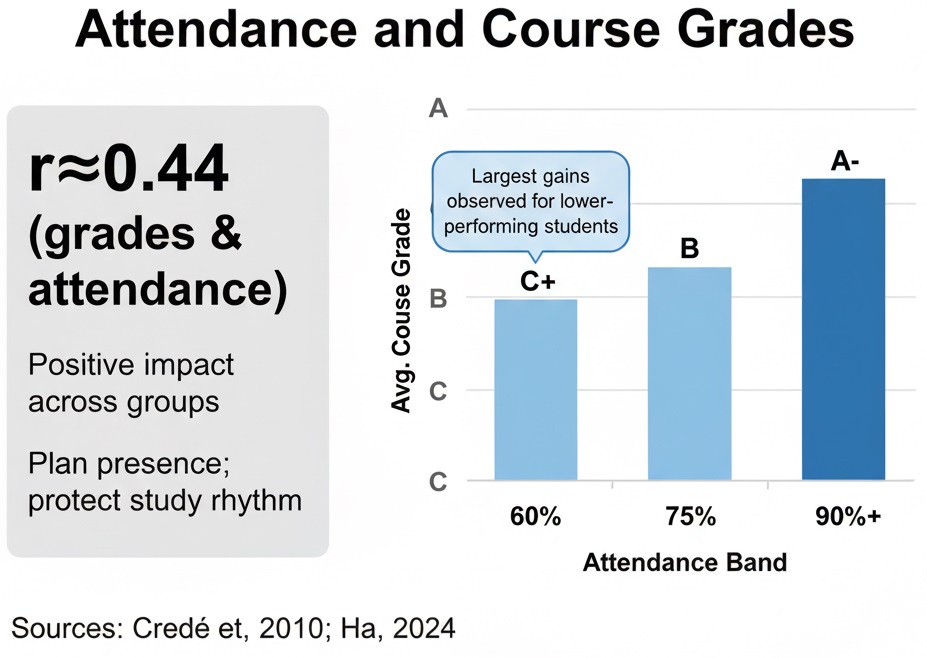
How Does College Discipline Impact Student Success?
College discipline covers the everyday rules that guide learning. It includes attendance and participation expectations, academic integrity in college, classroom norms, and student conduct processes. When these parts work together, students engage more, learn more, and stay on track. Clear rules reduce confusion. Fair procedures build trust. Educational responses help learners correct course without shame. You get a system that supports effort, focus, and responsible choices—key drivers of student success.
This article brings those parts together. It offers practical steps for you, your instructors, and your institution. It keeps the tone human, uses plain language, and points to actions you can use right away. Policies matter, but how people apply them matters even more.
Table of Content
- How Does College Discipline Impact Student Success?
- What College Discipline Covers
- How Discipline Shapes Student Success
- Attendance and Participation: Practical Guidance
- Academic Integrity in College: Policies That Work
- Student Conduct: Restorative Responses
- Procedural Fairness and Sense of Belonging
- Course-Level Clarity: The Learner-Centered Syllabus
- Generative Tools and Assessment Integrity
- Equity Notes: First-Generation and International Students
- Measuring Impact: Data to Track
- Common Risks and Simple Fixes
- Action Checklists
- Conclusion
- FAQs
What College Discipline Covers
College discipline goes beyond penalties. It blends guidance, accountability, and support. Key parts:
-
Attendance and participation expectations
-
Academic integrity rules and processes
-
Classroom norms set through a clear, learner-centered syllabus
-
Student conduct procedures, including restorative options
-
Consistent communication about rights, responsibilities, and appeal routes
Every one of these signals what the community values. Presence shows commitment to shared learning. Integrity protects fair assessment. Respect keeps discussions productive. Consistency builds trust.
How Discipline Shapes Student Success
Self-regulation and follow-through
Predictable structures help learners plan. Regular check-ins, participation points, and scheduled feedback cycles nudge follow-through. You know what to do, when to do it, and how work will be judged. Less guesswork. More progress.
Signals and norms
Policies send messages about priorities. A short “why this policy exists” note inside the syllabus tells students that rules support learning, not control. When multiple courses speak the same language, behavior becomes more consistent.
Fairness and belonging
Students engage when processes feel fair. Clear steps, reasonable timelines, and dignified treatment increase trust. Belonging grows when learners feel seen and heard. A fair system tells students: “You matter here,” which supports persistence through hard weeks.
Learning continuity
Regular presence keeps you in the loop: practice, feedback, adjustment. This loop drives learning in labs, studios, seminars, and lectures. Miss the loop, and small gaps turn into larger gaps. Good attendance and meaningful participation protect progress.
Attendance and Participation: Practical Guidance

Policy design that supports learning
-
Tie presence to learning tasks—peer review, quick writes, data collection, demonstrations—rather than seat time.
-
Offer participation through varied modes: short in-class responses, small-group labs, short online reflections when needed.
-
Publish a short rationale: “Presence helps you practice the skills assessed in Weeks 4–12.”
Flexible participation without grade inflation
-
Provide a limited number of tokens or make-up options for illness, caregiving, religious observance, or shift work.
-
Keep the number small and fixed from the start. Clear limits prevent unfair advantage.
-
Ask for brief documentation only when stakes are high. Respect privacy where possible.
Tips for you
-
Treat attendance like a weekly appointment with your future self.
-
Use a simple plan: calendar blocks for class, travel buffers, and a ten-minute review after each session.
-
If life gets in the way, contact your instructor early. A quick message often keeps you in rhythm.
Academic Integrity in College: Policies That Work

Clear expectations
Students make better choices when rules are plain. Use short examples that show what counts as plagiarism, what collaboration is allowed, and what support is off-limits. For you, this means fewer grey areas and less stress. For instructors, this means fair and consistent grading.
Course policy examples that help:
-
“You may discuss ideas with peers before drafting. You may not share text or code.”
-
“Quotation + citation for exact words; paraphrase + citation for ideas.”
-
“Citation managers and grammar checkers are allowed. Contract writing services are banned.”
Assessment design that limits cheating
-
Use authentic tasks: unique data sets, oral checkpoints, process portfolios, and in-class builds.
-
Stage work into drafts and feedback cycles. Copy-and-paste shortcuts lose value when the process matters.
-
Rotate prompts and datasets across terms to reduce recycling.
Sanctions that teach
-
For first-time, low-level breaches: a short integrity module, annotated revision with citation coaching, and a recorded outcome that escalates only if behavior repeats.
-
For higher-level breaches or repeat issues: stronger sanctions that match the impact on assessment fairness.
-
Publish typical ranges and timelines so learners know what to expect.
Student Conduct: Restorative Responses
When to use restorative pathways
Restorative options fit cases where harm is real yet repairable. A dorm dispute, classroom disruption, or minor property damage can become a learning moment. Restorative steps invite acknowledgment, dialogue, and a concrete plan to make things right.
Steps that build learning
-
Preparation: each student meets a trained staff member to clarify goals and needs.
-
Conference: those affected share impact; the student at fault explains choices and listens.
-
Agreement: actions match the harm—apology, service, restitution, learning tasks—and include deadlines.
-
Follow-up: a check for completion and reflection on what changed.
Campuses that use these steps report stronger gains in ethical reasoning and community responsibility. Exclusion remains an option for threats to safety or repeated harm. Most first incidents do not need that route.
Procedural Fairness and Sense of Belonging
What fairness looks like to learners
-
Clear definitions and examples
-
Predictable timelines and communication
-
A chance to share context before a decision
-
A respectful tone in meetings and letters
-
A right to appeal with guidance on how to do it
When learners see these parts in practice, trust grows. Engagement follows.
Reducing bias and disparate impact
-
Train staff and panel members on bias interruption.
-
Track outcomes by course, program, and student group.
-
Review language for jargon and replace with plain terms.
-
Provide a support person or advisor during meetings when requested.
This work protects both standards and equity. The message is simple: equal rules, equal respect.
Course-Level Clarity: The Learner-Centered Syllabus
Tone and structure
A syllabus is the first discipline touchpoint most students read. A learning-focused tone invites participation. A curt or punitive tone pushes students away. You can set an inclusive tone with a short welcome, clear goals, and tips for success in the course style (lab, studio, seminar, coding, fieldwork).
What to include
-
A one-paragraph course purpose in plain language
-
Weekly rhythm: when to prep, when to practice, when to submit
-
Participation and attendance expectations with rationale
-
Academic integrity in college: boundaries for collaboration and source use
-
A brief statement on digital and generative tools for each assessment
-
How to reach help: office hours, tutoring, writing center, lab assistants
-
A process map for extensions, appeals, or reporting concerns
Small effort here prevents confusion later.
Generative Tools and Assessment Integrity
Closed vs open tasks
-
Closed tasks: no external tools. Use secure settings when independent thinking, recall, or live problem solving is the goal.
-
Open tasks: tools allowed with attribution. Ask students to explain what they used, what they kept, and what they changed. This mirrors real practice in many fields.
Process evidence
Collect traces that show learning: drafts, design notes, code comments, lab logs, version histories, or short oral checks. These artifacts reward genuine work and discourage shortcuts. State expectations on each assignment page so no one has to guess.
Equity Notes: First-Generation and International Students
Removing the hidden curriculum
The hidden curriculum refers to steps insiders know and newcomers rarely see. Think documentation rules, appeal forms, or how to talk with an instructor about a deadline. Make those steps visible.
Helpful moves:
-
Orientation videos on integrity, conduct, and appeals
-
A glossary of common terms with short examples
-
Template emails that model respectful requests
Language and support
-
Offer language support during meetings when requested.
-
Allow a trained support person in conduct or integrity discussions.
-
Write letters in plain language with headings, bullets, and timelines.
These changes help every learner, not only students new to the system.
Measuring Impact: Data to Track
Course metrics
-
Attendance and participation rates across weeks
-
Links between participation and grades within each section
-
Number and type of integrity incidents, time to resolution, and reflections
-
Short pulse checks on fairness after policy changes
Program and campus metrics
-
Conduct outcomes: completion of agreements, later reports within 6–12 months
-
Access to support: tutoring visits, office hours, writing center usage
-
Belonging and climate snapshots each term
-
Disaggregation by student group to spot unequal impacts early
Data helps you fix real problems. Share summary trends with students and staff so everyone sees progress and next steps.
Common Risks and Simple Fixes
-
Over-policing minor issues. Use coaching for first mistakes. Save severe sanctions for repeat or high-impact harm.
-
Policy drift across sections. Use shared templates with room for course-specific notes.
-
Unclear tool rules. State where digital or generative tools are banned, allowed, or required for each task.
-
One-way hearings for learning goals. Use restorative steps when harm is repairable and risk is low.
-
Heavy jargon. Replace with plain language and examples.
Action Checklists
For colleges and universities (our institutional lens)
-
Publish a one-page map of conduct and integrity processes, including contacts and timelines.
-
Train staff and panel members on procedural fairness and respectful communication.
-
Offer restorative options for suitable cases and track learning outcomes over time.
-
Run periodic climate and integrity surveys using stable instruments.
-
Review case data each term and share a short annual summary with the campus.
For faculty (your course lens)
-
Explain the learning purpose behind attendance and participation.
-
Use participation designs that require presence for peer learning or practice.
-
Add a learning-focused syllabus section with simple tips for success.
-
State collaboration boundaries and tool rules on every assignment page.
-
Use proportionate, educational sanctions for first-time, low-level breaches.
-
Provide early feedback cycles so students can fix mistakes before high-stakes grading.
For students and learners (your success lens)
-
Treat presence like a weekly training plan. Block time for class and short review.
-
Ask for clarification on collaboration rules before group work.
-
Keep drafts and notes. They show progress and protect your work history.
-
If a concern arises, contact the instructor or student services early. Waiting rarely helps.
-
After any incident, reflect on what changed: time plan, study method, or communication habit.
Conclusion
Discipline supports learning when it is clear, fair, and educational. Attendance policies that link presence with purposeful activity help students build habits. Integrity systems that teach protect assessment quality and reduce repeat issues. Restorative responses help learners repair harm and return to community life with stronger judgment. A learner-centered syllabus sets the tone from day one. Fair procedures build trust and belonging. When colleges, faculty, and students work from the same playbook, student success follows.
FAQs
How do attendance rules help students who work long hours or commute?
Attendance helps when presence connects to practice and when limited flexibility exists. Short online reflections, peer notes, or one token per term protect access without lowering standards. Plan your week with buffers for travel and family needs.
What is a good first response to minor plagiarism?
Education with accountability. Ask for a corrected draft with citations, add a short learning module, and record the outcome. Escalate only if behavior repeats.
Do restorative approaches go easy on misconduct?
No. Restorative steps require acknowledgment of harm, a plan to repair, and follow-through. They work well for first incidents and repairable harm. Safety risks and repeated harm still require stronger measures.
How should courses handle generative tools?
State the rule for each task: banned, allowed with attribution, or required. Ask for process evidence such as drafts or short orals. Use authentic tasks that reflect real practice in the field.
What makes a syllabus support discipline rather than feel punitive?
Tone and clarity. Begin with course purpose, show how to succeed, give examples for integrity and collaboration, and add a short “why this policy exists” note. Students read tone as much as rules.
Education Students

